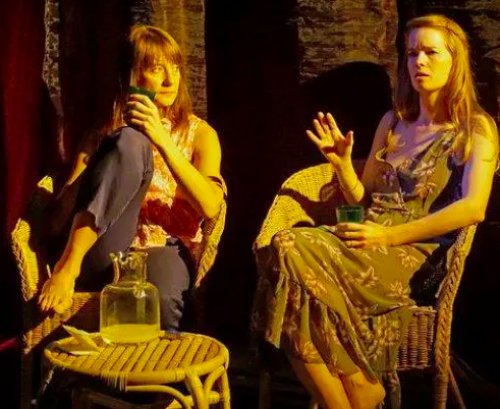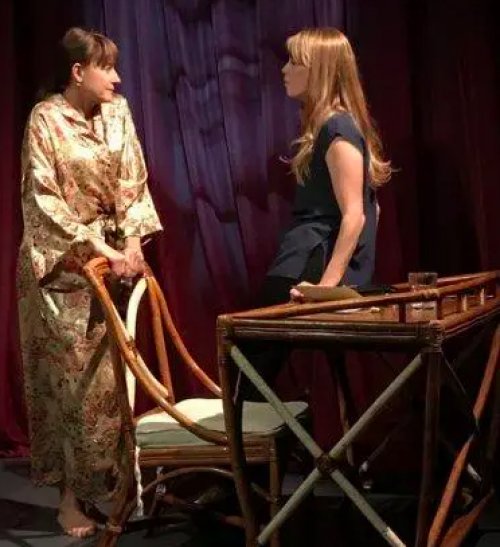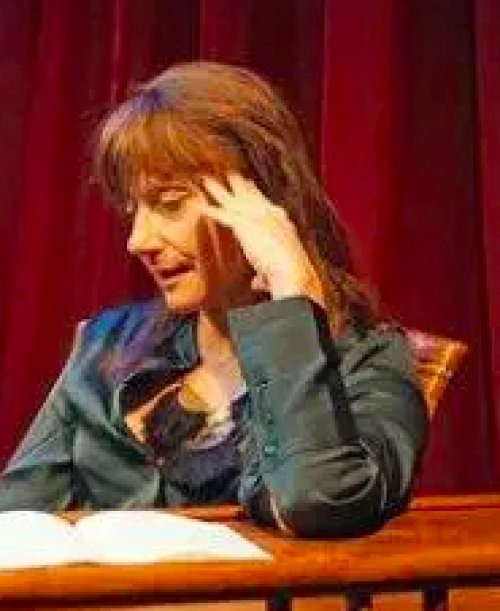
By: Darryl Reilly
This spellbinding drama by playwright Richard Vetere spans over two decades and is about two lesbian poets and one’s daughter. Lady Macbeth and Her Lover is brilliantly performed and smartly staged.
The familiar All About Eve angle of the younger supplanting the older is given a literary spin here with touches of Ingmar Bergman and Woody Allen in his serious mode. This is an inventive take on the dramatic territories of Sylvia Plath, Anne Sexton and Elizabeth Bishop.
Middle-aged Corrine is an acclaimed poet who won a Pulitzer Prize for her collection, Lady Macbeth and Her Lover, and is a professor of poetry at New York State’s Stony Brook University. That volume was inspired by her deep emotional and sexual relationship with Hope. She was a poet as well, and achieved posthumous fame and a Pulitzer Prize after committing suicide.
Twenty years later, her 28-year-old daughter Emily shows up at Corrine’s house on Hope’s birthday to get Corrine to sign her copy of Corrine’s book. The two have never met before. Emily is an aspiring poet and has brought along some of her poems. Inevitably, a complex relationship between the two women develops.
We were on what we called a ‘field trip.’ We read Ode to
Autumn in front of John Keat’s house in Hempstead Heath. We
sang Paint It Black in front of Mick Jagger’s house in
Richmond and we went to Harold Pinter’s house and paused.
Your youth is contagious.
Love me or leave my house.
I’ll make you a drink. Something tasty. With vodka.
What does that have to do with happiness?
Everything.
Mr. Vetere’s dialogue is elegantly crafted and a joy to listen to, realizing the academic milieu with authenticity. Vetere’s construction is taut and his accomplished writing all results in a harrowing and suspenseful piece where the past is always present in the play’s ten scenes. A major achievement of his play is providing three riveting roles for women that are brilliantly performed by two actresses.

With her marvelously fluty voice, imperious bearing, expressive physicality and animated facial features, Maja Wampuszyc as the haughty Corrine recalls Geraldine Page in all her grand glory. Ms. Wampuszyc is mesmerizing, delivering a searing performance of tremendous depth. She vividly conveys the character’s dysfunctional sensibility with heightened emotionalism and dry humor.
The blonde, girlish and alluring Christy Escobar as Hope and Emily is magnetic. Modulating her husky voice and slightly altering her appearance, Ms. Escobar delivers two commanding characterizations. Each character is fraught with angst, despair and talent, and Escobar perfectly conveys these qualities.
Director Michelle Bossy surmounts the challenges of the very small space with her clever staging. The contained playing area is set up at an angle adding visual interest. Ms. Bossy weaves the performance and technical elements into an aesthetic presentation that makes it gripping to watch.
To show the passage of four years, the stage is dimly lit. Corrine changes her clothes with a black clad crewmember at her side. The crewmember eventually paints a few gray streaks on Corrine’s hair. Rather then being distracting, this intrusion becomes a haunting, brief Kabuki-style sequence.
Film noir, golden hues, eerie darkness and atmospheric dimness, are striking components of Cheyenne Sykes’ awesome lighting design that’s ever present. Occasionally, projections of black and white pictures of Hope are shown on the stage’s back wall for symbolic effect.
Attractive wicker furniture, a cluttered desk, photographs and gauzy curtains are all swiftly reconfigured into different rooms by Brittany Vasta’s highly imaginative scenic design.
Operatic selections, rumbling electronic music and appropriate effects are seamlessly and moodily emitted throughout the presentation due to Matthew Sullivan’s intense sound design.
A Bohemian print dress, black ensembles and everyday wear are features of Jennifer Fisher’s exquisite costume design that represents the characters with artful realism.
From its dreamy prologue to its stunning conclusion, Lady Macbeth and Her Lover is powerfully enchanting.
Lady Macbeth and Her Lover (through November 19, 2017)
The Directors Studio at The Directors Company
311 West 43rd Street, Suite 409, in Manhattan
For tickets, call 212-868-4444 or visit http://www.smarttix.com
For more information: http://www.directorscompany.org
Running time: two hours including one intermission
